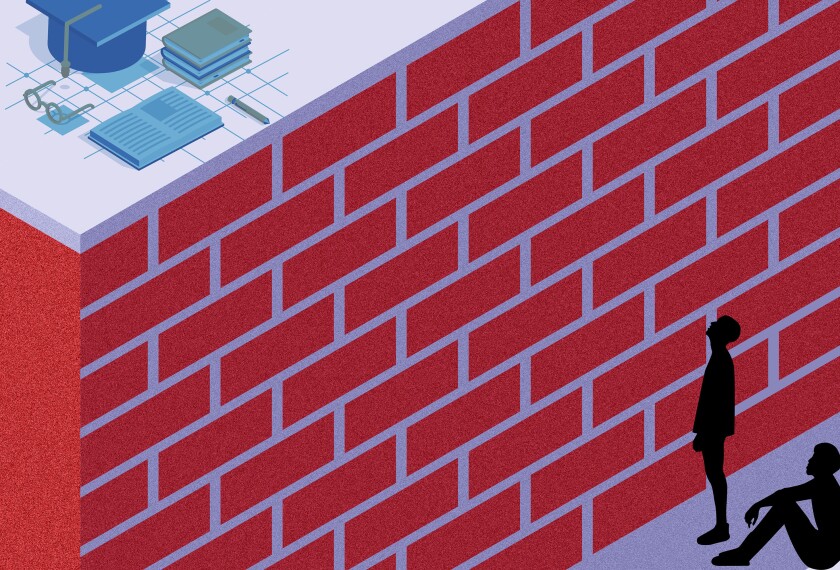From the beginning, educators have seen pandemic recovery as a marathon rather than a sprint. The latest data suggest helping students regain academic ground could be more of a yearslong endurance trek—one that is likely to outlast current federal and state money to support it.
The NWEA, which administers widely used adaptive tests, tracked the progress of 8.3 million students nationwide in grades 3-8 from 2015-16 through 2021-22. It found that in the last school year, students began to progress in reading and math at rates closer to their progress before the pandemic.
However, by the end of the 2021-22 school year, student achievement was still 5-10 percentile points lower in math and 2-4 percentile points lower in reading than in a typical pre-pandemic year. Moreover, the small improvements that did come were in elementary grades. The pandemic-era declines in middle school achievement have been unchanged.
If improvements continue at the pace they have been, NWEA researchers predict the average elementary student will take three years, at minimum, to return to their pre-pandemic academic trajectory, and older students will take “far longer.” For example, in both reading and math, NWEA estimates students who were in grades 5 and 6 during the last school year could need up to five years to fully recover, and even more time is needed for those entering 8th grade or high school in the fall.
“Even though we see evidence of improvements in both math and reading, clearly we have a farther way to go,” said Karyn Lewis, the director of the Center for School and Student Progress at NWEA and a co-author of the study with NWEA research scientist Megan Kuhfeld. “This timeline for recovery is extending well past the availability of those [federal] recovery funds. I think there’s a real urgency right now to figure out what’s working and scale it up so that we can improve at even faster rates and make sure that we are able to sustain those improvements.
“Once the federal recovery funds are gone [in 2024], I’m seeing just continuing gaps widening, particularly for historically marginalized student groups who were also the hardest hit in the pandemic,” Lewis said.
The study found students of all racial groups and in both high- and low-poverty schools have improved, but those in low-poverty schools have rebounded faster. While the study did not look at why, other research has suggested wealthier schools have had more intervention resources and communities less affected by the pandemic.
It’s not clear why elementary students have rebounded faster than middle school students, but Lewis said early reports of dramatic learning loss in K-3 may have made schools concentrate on interventions for younger students. Moreover, she said, “middle schoolers are a harder group to intervene upon—harder to get to enroll in things like summer school and Saturday academies. They probably have a little bit more autonomy than younger students and may be more reluctant to engage.”
Recovery likely slower than other disasters
In a during the three years of the pandemic, NWEA researchers found the academic effects of the pandemic have been worse and more long-lasting than those of other school disruptions, such as Hurricane Katrina. Other studies have found students who were displaced and who missed from five weeks to four months of school as a result of the 2005 Gulf Coast storm; however, students generally returned to pre-hurricane academic trajectories in about of regular schooling.
But COVID-19 differs from prior emergency disruptions in several ways.
For one, even schools that have in-person learning have yet to return to pre-pandemic “normal.” As recently as spring 2022, some schools still closed or moved to remote learning in response to outbreaks of the omicron variant of the coronavirus. Many more schools that have remained in-person consistently still deal with significantly higher chronic absenteeism, as students and staff become infected or have to quarantine after being exposed to the virus. Rolling absences require more reteaching and reduce teachers’ ability to help classes recoup lost content.
Rates of stress, trauma, and other mental health and behavioral problems have also been more widespread and ongoing during the pandemic than in natural disasters, creating a heavier load for both classroom management and student supports.
“We have a larger magnitude of unfinished learning in high-poverty schools and for historically marginalized students and especially the intersection of those two things,” Lewis said. “So when it comes time to target [funds] that means prioritizing and intervening for those students in particular, making sure we are getting them the supports they need to get back on track.”





